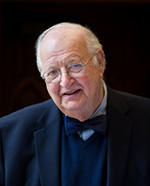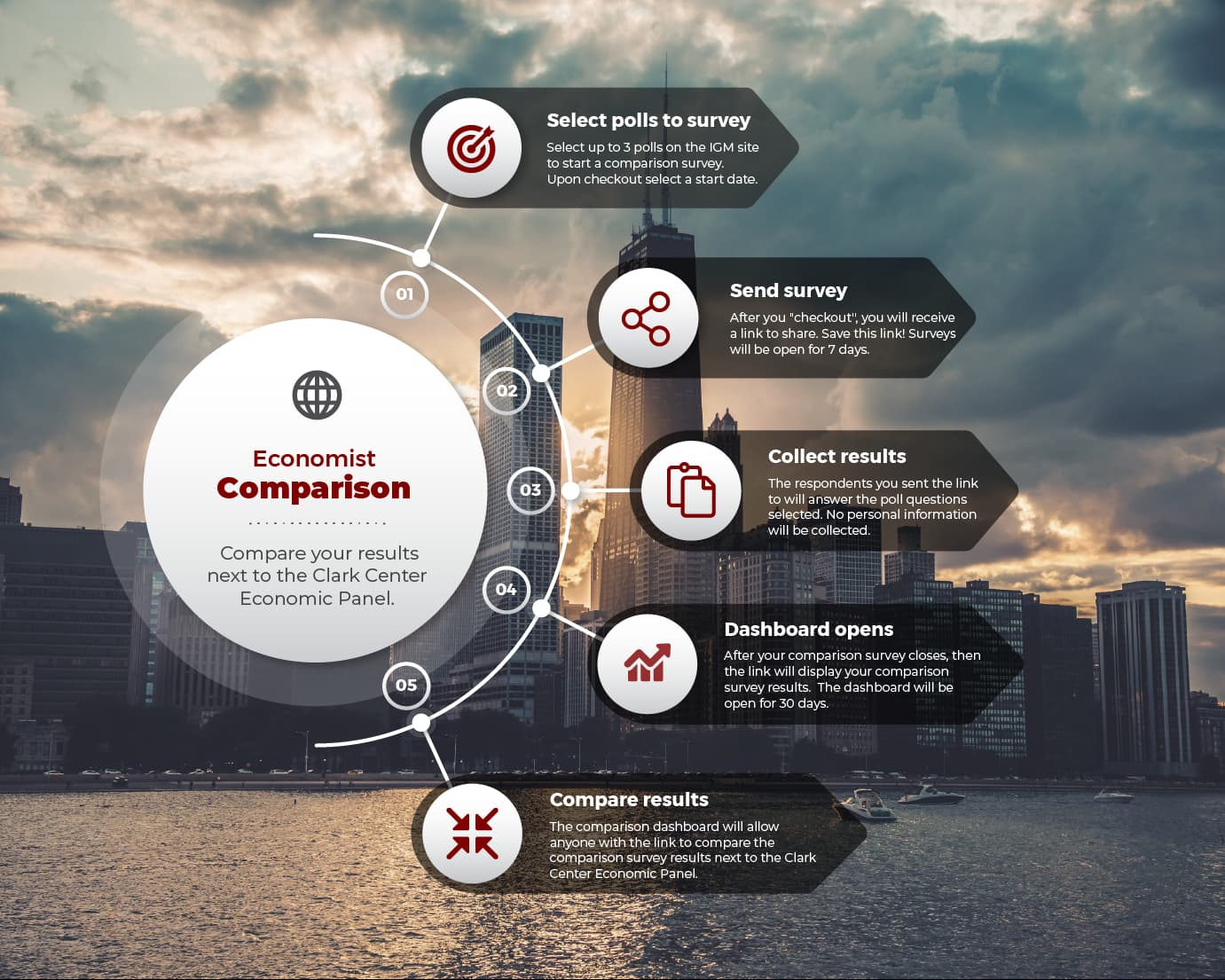Question A:
All else equal, permanently raising the federal marginal tax rate on ordinary income by 1 percentage point for those in the top (i.e., currently 35%) tax bracket would increase federal tax revenue over the next 10 years.
Responses
Responses weighted by each expert's confidence
Question B:
The cumulative budget shortfalls in the US over the next 10 years can be reduced by half (or more) purely by increasing the federal marginal tax rate on ordinary income for those in the top tax bracket.
Responses
Responses weighted by each expert's confidence
Question A Participant Responses
| Participant | University | Vote | Confidence | Bio/Vote History |
|---|---|---|---|---|
 Daron Acemoglu |
MIT | Bio/Vote History | ||
|
Disincentive effects on labor supply and entrepreneurship, and tax avoidance are likely, but not large enough to reduce revenues.
|
||||
   Alberto Alesina |
Harvard | Bio/Vote History | ||
|
|
||||
   Joseph Altonji |
Yale | Bio/Vote History | ||
|
The labor supply literature strongly suggests that the revenue gain from a higher rate will outweigh a small reduction in labor supply.
|
||||
   Alan Auerbach |
Berkeley | Bio/Vote History | ||
|
|
||||
   David Autor |
MIT | Bio/Vote History | ||
|
We are nowhere near the downward sloping side of the Laffer curve.
|
||||
   Katherine Baicker |
University of Chicago | Bio/Vote History | ||
|
Bigger question is what the economic cost would be, but unlikely to be so large that revenues would actually decline.
|
||||
   Marianne Bertrand |
Chicago | Bio/Vote History | ||
|
|
||||
   Raj Chetty |
Harvard | Bio/Vote History | ||
|
|
||||
   Judith Chevalier |
Yale | Bio/Vote History | ||
|
The behavioral response cannot possibly be big enough to wipe out the revenue gains.
|
||||
   Janet Currie |
Princeton | Bio/Vote History | ||
|
There are many people in the top bracket, and while some would be able to change their behavior to offset the increased tax, not all would.
|
||||
   David Cutler |
Harvard | Bio/Vote History | ||
|
The elasticities are not that high.
|
||||
   Angus Deaton |
Princeton | Bio/Vote History | ||
|
This seems quite clear.
|
||||
   Darrell Duffie |
Stanford | Bio/Vote History | ||
|
Is the net effect on revenues negative because of the impacts on avoidance and earning efforts? That's not clear, but probably not.
|
||||
   Aaron Edlin |
Berkeley | Bio/Vote History | ||
|
Labor elasticity should be less than 1 and might in fact go either way. Federal Revenue could be used in helpful ways.
|
||||
   Barry Eichengreen |
Berkeley | Bio/Vote History | ||
|
|
||||
   Ray Fair |
Yale | Bio/Vote History | ||
|
This would not put us on the bad part of the Laffer curve.
|
||||
   Pinelopi Goldberg |
Yale | Bio/Vote History | ||
|
A 1% increase seems too small to impact hours worked, productivity or consumption in the top bracket.
|
||||
   Claudia Goldin |
Harvard | Bio/Vote History | ||
|
There are some good estimates showing that higher taxes at the top nets more income. Labor SS response is low as is falsification of income
|
||||
   Austan Goolsbee |
Chicago | Did Not Answer | Bio/Vote History | |
|
|
||||
   Michael Greenstone |
University of Chicago | Bio/Vote History | ||
|
CBO's analysis indicates that the Bush tax cuts reduced revenue so presumably undoing part of this decrease in rates would increase revenue.
-see background information here |
||||
|
Robert Hall |
Stanford | Bio/Vote History | ||
|
Close call. Depends on enforcement efforts. Prior to 1986, taxpayers in the high bracket seemed to be willing to buy inefficient shelters.
|
||||
   Bengt Holmström |
MIT | Bio/Vote History | ||
|
|
||||
   Caroline Hoxby |
Stanford | Did Not Answer | Bio/Vote History | |
|
|
||||
   Kenneth Judd |
Stanford | Bio/Vote History | ||
|
Some activities will change little, such as labor supply, but some will increase tax avoidance efforts. My guess is a weak revenue increase.
|
||||
   Anil Kashyap |
Chicago Booth | Bio/Vote History | ||
|
|
||||
   Pete Klenow |
Stanford | Bio/Vote History | ||
|
Forecasting the forecast of others (Chetty, Saez, ...).
-see background information here |
||||
   Edward Lazear |
Stanford | Bio/Vote History | ||
|
Revenue would rise, but the important question is what happens to growth, not revenue. The goal is not to maximize the size of government.
|
||||
   Jonathan Levin |
Stanford | Bio/Vote History | ||
|
Saez puts top of the Laffer curve above 60%, suggesting we're well to the left.
|
||||
   William Nordhaus |
Yale | Bio/Vote History | ||
|
Weight of evidence on personal tax rate with some reservations about other (state and local) taxes and other interactions.
|
||||
   Maurice Obstfeld |
Berkeley | Bio/Vote History | ||
|
It is doubtful such a small tax increase would materially affect behavior.
|
||||
   Cecilia Rouse |
Princeton | Bio/Vote History | ||
|
|
||||
   Emmanuel Saez |
Berkeley | Bio/Vote History | ||
|
Based on best estimates and even with current tax code, US top rate is still significantly below revenue maximizing tax rate
|
||||
   José Scheinkman |
Columbia University | Bio/Vote History | ||
|
|
||||
   Richard Schmalensee |
MIT | Bio/Vote History | ||
|
|
||||
   Hyun Song Shin |
Princeton | Bio/Vote History | ||
|
|
||||
   James Stock |
Harvard | Bio/Vote History | ||
|
|
||||
   Nancy Stokey |
University of Chicago | Bio/Vote History | ||
|
There is a Laffer Curve, but 35% is to the left of the peak.
|
||||
   Richard Thaler |
Chicago Booth | Bio/Vote History | ||
|
The Laffer curve should have stayed on the napkin.
|
||||
   Christopher Udry |
Northwestern | Bio/Vote History | ||
|
|
||||
   Luigi Zingales |
Chicago Booth | Bio/Vote History | ||
|
The negative effect on growth would have to be huge to offset the tax revenues raised.
|
||||
Question B Participant Responses
| Participant | University | Vote | Confidence | Bio/Vote History |
|---|---|---|---|---|
   Daron Acemoglu |
MIT | Bio/Vote History | ||
|
More comprehensive increases in taxes and reduction in tax expenditures, or preferably systematic means testing of SS-Medicare are necessary
|
||||
   Alberto Alesina |
Harvard | Bio/Vote History | ||
|
|
||||
   Joseph Altonji |
Yale | Bio/Vote History | ||
|
Broad based tax reform and reductions in projected expenditures, particularly on health, will be required.
|
||||
   Alan Auerbach |
Berkeley | Bio/Vote History | ||
|
|
||||
   David Autor |
MIT | Bio/Vote History | ||
|
Unfortunately, not enough income there to do it (I think)
|
||||
   Katherine Baicker |
University of Chicago | Bio/Vote History | ||
|
I think depends on how shortfall defined (current law vs. current policy, etc.) - but not a good idea in either case, esp. in longer run.
|
||||
   Marianne Bertrand |
Chicago | Bio/Vote History | ||
|
|
||||
   Raj Chetty |
Harvard | Bio/Vote History | ||
|
|
||||
   Judith Chevalier |
Yale | Bio/Vote History | ||
|
My back of the envelope suggests no, but I think a PF person would have more of the numbers at their disposal.
|
||||
   Janet Currie |
Princeton | Bio/Vote History | ||
|
Medicare (and to a lesser extent Social Security) are big drivers of the deficit, so changes are necessary to bring it under control.
|
||||
   David Cutler |
Harvard | Bio/Vote History | ||
|
I don't know offhand what the estimates are at different elasticities.
|
||||
   Angus Deaton |
Princeton | Bio/Vote History | ||
|
I don't know the magnitudes well enough to know whether or not this is likely to be the case.
|
||||
   Darrell Duffie |
Stanford | Bio/Vote History | ||
|
It is a difficult question (for me at least).
|
||||
   Aaron Edlin |
Berkeley | Bio/Vote History | ||
|
According to CBO estimates, maybe if rates go sky high. According to Gale and Auerbach, deficit far too big. links on my webpage.
-see background information here |
||||
   Barry Eichengreen |
Berkeley | Bio/Vote History | ||
|
|
||||
   Ray Fair |
Yale | Bio/Vote History | ||
|
I don't know the tax distribution data well enough.
|
||||
   Pinelopi Goldberg |
Yale | Bio/Vote History | ||
|
Tremendous uncertainty around these projections. Also, given the complexity of the tax code, taxpayers find ways around specific rate hikes
|
||||
   Claudia Goldin |
Harvard | Bio/Vote History | ||
|
Don't have any idea if it would be one-half. That seems rather large. But if it were true -- let's do it.
|
||||
   Austan Goolsbee |
Chicago | Did Not Answer | Bio/Vote History | |
|
|
||||
   Michael Greenstone |
University of Chicago | Bio/Vote History | ||
|
Unknown elasticities and unclear baseline (do other Bush tax cuts expire? future of Medicaid/Medicaid?) make it very difficult to evaluate
|
||||
|
Robert Hall |
Stanford | Bio/Vote History | ||
|
There's a CBO-style "current law" assumption here that is hard to deal with--does the AMT come back in its old form or continue to be cut?
|
||||
   Bengt Holmström |
MIT | Bio/Vote History | ||
|
|
||||
   Caroline Hoxby |
Stanford | Did Not Answer | Bio/Vote History | |
|
|
||||
   Kenneth Judd |
Stanford | Bio/Vote History | ||
|
The rich don't have that much money, and would respond with substantial increases in tax avoidance activities.
|
||||
   Anil Kashyap |
Chicago Booth | Bio/Vote History | ||
|
Too many ways to shift income. If the rate becomes very high labor supply will probably fall. Everyone will have to pay to cut the deficits
|
||||
   Pete Klenow |
Stanford | Bio/Vote History | ||
|
Doesn't look close according to these calculations (see link).
-see background information here -see background information here |
||||
   Edward Lazear |
Stanford | Bio/Vote History | ||
|
Using the President's numbers, the gaps are too big, more so if we go beyond 10 years. Scoring of tax increase do not show big deficit cuts.
|
||||
   Jonathan Levin |
Stanford | Bio/Vote History | ||
|
How could this be? CBO projects $1tr annual deficits. Annual income tax revenues from $500+k earners are now $350bn. We're going to 3x this?
|
||||
   William Nordhaus |
Yale | Bio/Vote History | ||
|
Close call. With 10 yr CBO baseline def of $6 tr, indiv inc taxes of $19 tr, top 1% pays 40% of that, 50% rate. If really "purely," then no.
-see background information here |
||||
   Maurice Obstfeld |
Berkeley | Bio/Vote History | ||
|
The budget shortfalls are too large to be covered on this income tax base. Both tax and entitlement reform will be needed.
|
||||
   Cecilia Rouse |
Princeton | Bio/Vote History | ||
|
|
||||
   Emmanuel Saez |
Berkeley | Bio/Vote History | ||
|
Enough income at top to cut deficit by 50%+ but need to go after it after base broadening not solely by increasing current ordinary top rate
|
||||
   José Scheinkman |
Columbia University | Bio/Vote History | ||
|
|
||||
   Richard Schmalensee |
MIT | Bio/Vote History | ||
|
|
||||
   Hyun Song Shin |
Princeton | Bio/Vote History | ||
|
|
||||
   James Stock |
Harvard | Bio/Vote History | ||
|
|
||||
   Nancy Stokey |
University of Chicago | Bio/Vote History | ||
|
The top bracket is a very small group. Maybe with the top 10% of the income distribution. But how are we defining "budget shortfalls"?
|
||||
   Richard Thaler |
Chicago Booth | Bio/Vote History | ||
|
Only a small part of the puzzle. Tax reform anyone?
|
||||
   Christopher Udry |
Northwestern | Bio/Vote History | ||
|
|
||||
   Luigi Zingales |
Chicago Booth | Bio/Vote History | ||
|
cumulative deficit is 10 trillion. taxable income at the 35% 600 billions. to halve the deficit you will need 100% tax rate. Impossible
|
||||

